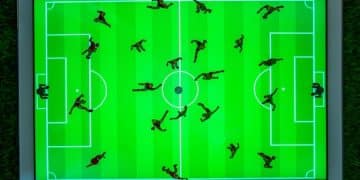The US Soccer Fan’s Guide to Understanding VAR and Its Impact

A Comprehensive exploration of the Video Assistant Referee (VAR) system, detailing its origins, implementation, and profound impact on major soccer competitions, designed to help US fans fully grasp its evolving role in the beautiful game.
For many avid soccer fans in the US, understanding the intricacies of the game can be a journey. One of the most significant and often debated additions to modern soccer is the Video Assistant Referee, or VAR. This guide aims to demystify VAR, offering a clear perspective on its role, how it operates, and its undeniable impact on the sport we love.
What is VAR and How Did it Originate?
The Video Assistant Referee system, commonly known as VAR, represents a significant technological leap in soccer officiating. At its core, VAR is a tool designed to assist the on-field referee in making correct decisions during specific, pre-defined game-changing situations. It’s not intended to re-referee the entire match, but rather to minimize clear and obvious errors, thereby enhancing fairness and justice in crucial moments. The concept behind VAR began to take shape over a decade ago, spurred by a growing desire to leverage technology to reduce the impact of human error in high-stakes matches. For years, major sporting events in other disciplines had successfully integrated video review, leading many in the soccer world to question why the sport, so globally popular, lagged behind.
The impetus for its development gained momentum after several high-profile incidents where incorrect decisions directly influenced the outcome of significant matches. FIFA, along with the International Football Association Board (IFAB), which governs the Laws of the Game, recognized the need for change. They initiated trials to explore how video technology could be practically and effectively incorporated without fundamentally altering the flow or traditions of the sport. Early trials were conducted in various leagues and competitions worldwide, starting with more limited applications and gradually expanding the scope as the technology and protocols evolved. These initial tests were vital for understanding the technical requirements, the practical implications on game flow, and the psychological impact on players, coaches, and fans. The objective was clear: use technology to support, not supplant, the human element of officiating.
The Genesis of VAR: Addressing a Need
The journey from concept to implementation was deliberate and cautious. Soccer’s global appeal meant any fundamental change would face intense scrutiny. Early discussions often centered on balancing the desire for accuracy with the sport’s inherent fluidity. Major leagues and tournaments, like Major League Soccer (MLS) in the US, played a crucial role in these formative years. MLS was one of the first major leagues globally to embrace live testing of VAR, providing invaluable feedback to IFAB and FIFA directly from match scenarios. These real-world applications allowed for critical refinements to the system’s protocols.
- The primary goal: rectify “clear and obvious errors” and “serious missed incidents.”
- Early trials: began around 2016 in various youth and professional leagues.
- Focus areas: goals, red cards, penalties, and mistaken identity.
Key Milestones in VAR Adoption
The positive results from initial trials paved the way for wider adoption. The system slowly gained traction, moving from experimental phases to official integration in major competitions. The FIFA World Cup in 2018 marked a definitive turning point, bringing VAR onto the biggest global stage. This exposure, despite some initial controversies and learning curves, solidified VAR’s place in modern soccer. Discussions about its implementation continue on a global scale. Its introduction in the Premier League, one of the most-watched leagues in the US, further cemented its presence in the American fan’s viewing experience, bringing both frustration and celebrated moments of perceived justice.
Ultimately, VAR’s origin story is rooted in the pursuit of fairness. It emerged from a collective desire within the sport to leverage available technology to correct critical errors that can profoundly impact results, ensuring that the beautiful game remains as just as it is engaging. While its implementation continues to be refined and debated, its purpose—to aid referees in achieving accuracy—remains constant.
Understanding the VAR Protocol: When is VAR Used?
The rules governing when the Video Assistant Referee (VAR) can intervene are precisely defined, aiming to maintain the flow of the game while correcting only decisive errors. Unlike a comprehensive review of every play, VAR is reserved for specific “game-changing” situations. This selective intervention is at the heart of the VAR protocol, designed to strike a balance between accuracy and preserving the sport’s natural rhythm. The protocol specifies four distinct categories of incidents where VAR can be used, and in each case, the system looks for “clear and obvious errors” or “serious missed incidents.” This high threshold ensures that minor disagreements or subjective interpretations generally remain with the on-field referee.
The four categories are: goals, penalty incidents, direct red card incidents, and mistaken identity. For a decision to be reviewed, either the on-field referee initiates a review (a “referee review”) or the VAR team identifies a potential clear and obvious error and suggests a review (a “VAR-initiated review”). This dual approach ensures that both the referee on the field and the technical team off-field have a role in the review process. It’s important for fans to understand that not every single subjective call will be overturned; VAR is about correcting blatant mistakes that could unfairly influence the match outcome.
The Four Reviewable Incidents
Each of the four categories has specific criteria for review. For goals, VAR checks for any infraction that might have occurred in the build-up, such as offside, a foul leading to the goal, or the ball going out of play. This ensures that only legitimately scored goals stand. Penalty incidents are reviewed for clear and obvious errors in awarding or not awarding a penalty kick, including the location of the foul, the nature of the contact, and whether a foul actually occurred. This often involves checking if the foul happened inside or outside the box, or if a dive was mistakenly awarded as a penalty.
- ⚽ Goals: Disallowed for offside, foul play, or ball out of play in the attacking phase.
- 🥅 Penalty Incidents: Clear errors in awarding or not awarding a penalty (e.g., foul inside/outside the box, simulation).
- 🟥 Direct Red Card Incidents: Reviews only for direct red cards (not second yellows) for clear and obvious violent conduct, serious foul play, etc.
- 🎭 Mistaken Identity: When a referee sends off or cautions the wrong player.
The VAR Check and Review Process
When a potential clear and obvious error occurs, the VAR team, located in a remote operating room, checks replays from multiple camera angles. If they identify a potential error, they communicate this to the on-field referee through an earpiece. The referee then has two options: accept the VAR’s information (for factual decisions like offside), or go to the Referee Review Area (RRA) on the sidelines to view the incident on a monitor. The RRA review gives the referee the final say, reinforcing the principle that the on-field official always makes the ultimate decision. The process is designed to be as swift as possible to minimize disruptions to the game, though this is often a point of contention for fans frustrated by delays.
The referee signals VAR checks by touching their earpiece, and an official VAR review is indicated by the referee drawing a rectangle in the air, mimicking a screen. This visual cue informs players, coaches, and fans that a decision is being reviewed. Post-review, the referee will signal their final decision, whether it’s confirming the original call, overturning it, or changing a disciplinary action. Understanding these signals and the four types of incidents helps fans comprehend the pauses in play and the rationale behind specific decisions, making the VAR experience less bewildering and more transparent.

The Impact of VAR on Major Soccer Competitions
Since its widespread adoption, especially in major leagues and tournaments, VAR has undeniably reshaped the landscape of soccer officiating and match dynamics. Its presence has had multifaceted impacts, affecting everything from game flow and player behavior to fan experience and referee accountability. The most immediate effect is the reduction of clear and obvious errors in the four key game-changing situations. While no system is perfect, VAR has demonstrably corrected wrong calls that would have otherwise influenced results, leading to a perceived increase in overall fairness. However, this precision comes with its own set of trade-offs, sparking considerable debate among players, coaches, and fans alike.
The primary objective of VAR was to ensure justice in critical moments, and in many instances, it has achieved this. Controversial decisions that once dominated post-match analyses are now frequently reviewed and corrected in real-time. This has, in theory, made matches fairer and reduced grievances over highly impactful human errors. Yet, the method of achieving this fairness has introduced new elements that profoundly alter the viewing experience and the feel of the game. For example, goal celebrations are often delayed as fans and players await confirmation from the VAR room, diminishing the spontaneous joy that is such an integral part of soccer.
Changes in Game Flow and Player Behavior
One of the most noticeable impacts of VAR is on the rhythm and flow of the game. Pauses for VAR checks, especially for “on-field reviews,” can be lengthy, disrupting the natural momentum of play. This can be frustrating for players and fans, who often prefer continuous action. Managers also lament the unpredictability of these stoppages, which can affect tactical plans and player concentration. In terms of player behavior, there’s been some evidence of players adjusting their conduct, knowing that crucial incidents are under scrutiny. For example, blatant dives or clear fouls might be less frequent if players know they are likely to be caught by replays.
* Lengthy stoppages: Can break the rhythm of play and spectator immersion.
* Reduced dissent: Players are less likely to mob the referee for clear, reviewable incidents.
* Increased scrutiny: Every foul and offside, particularly in the attacking phase, is meticulously checked.
Referee Accountability and Fan Experience
VAR has placed referees under an even brighter spotlight. While it provides a safety net for major errors, it also highlights any misinterpretations or inconsistencies in its application, leading to increased scrutiny and criticism. The transparency, though intended to be positive, can sometimes feel like a public re-litigation of calls, contributing to fan frustration rather than alleviation. For fans, the experience is largely polarized. Some appreciate the increased accuracy and feel a greater sense of justice. Others feel it detracts from the spontaneous drama of the game, turning joyous goal celebrations into nervous waits. The subjective nature of some VAR decisions also continues to fuel debate, particularly around handball calls and the ever-so-slight offside margins.
The impact of VAR is a continuous evolution. While it has undoubtedly enhanced decision-making accuracy in key moments, the soccer community is still navigating its side effects, striving to find the optimal balance between technological assistance and the sport’s traditional characteristics. For US soccer fans, who are often exposed to a variety of sports with video review systems, adapting to VAR’s unique application in soccer has been a defining aspect of their modern viewing experience.
The Debate: Pros and Cons of VAR
The introduction of VAR has sparked one of the most intense and ongoing debates in modern soccer. While proponents champion its ability to ensure fairness and correct egregious errors, critics point to issues that, they argue, detract from the game’s essence. This dichotomy forms the core of the VAR discussion, with valid arguments on both sides. Understanding these differing perspectives is essential for any US soccer fan looking to grasp the full picture of VAR’s impact. The system was designed to eliminate “clear and obvious errors,” a term that itself is often subjective, leading to much of the contention.
On one hand, VAR has demonstrably corrected many high-impact mistakes that would have otherwise gone unpunished or been wrongly penalized. Goals scored from an offside position, incorrect red cards, and even phantom penalties have been overturned, leading to a more just outcome in specific instances. This accuracy enhances the integrity of matches, particularly in high-stakes competitions where a single decision can mean the difference between victory and defeat, or even promotion and relegation. The argument for fairness is compelling, especially for those who prioritize objective justice over the subjective flow of the game.
Arguments in Favor of VAR
Proponents of VAR highlight its core mission: to improve accuracy. By bringing technology to bear on critical decisions, the game moves closer to a truly merit-based outcome. Referees facing immense pressure now have a crucial tool to fall back on, potentially reducing the psychological burden of making an irreversible mistake. The data, in many leagues, suggests a significant reduction in incorrect decisions for the four reviewable categories.
- Increased Accuracy: Corrects “clear and obvious errors” in game-changing moments.
- Justice: Reduces the chance of a match being decided by a wrong call.
- Deterrence: May lead to less simulation and cynical fouls, knowing they are reviewed.
Common Criticisms Against VAR
Despite its benefits, VAR faces significant criticism. The most common complaint revolves around the disruption to the game’s flow. Lengthy pauses for reviews, particularly for marginal offside calls measured in millimeters or subjective handball decisions, can kill momentum and diminish the excitement of a goal celebration. Many fans argue that these delays remove spontaneity and emotional peaks from the match experience.

Another major point of contention is consistency. Despite the protocols, there can be varying interpretations of “clear and obvious” errors across different referees and leagues, leading to a perception of inconsistency. Handball rules, in particular, have been a constant source of debate, with seemingly identical incidents yielding different outcomes. There’s also the criticism that VAR over-officiates, taking away from the human element and the idea that minor errors are part of the game. Some purists argue that soccer, unlike other sports, naturally has more subjective calls, and over-reliance on technology changes its very character. The human element of error, for better or worse, has always been a part of the sport’s narrative, creating talking points and legendary moments that some feel are now being sanitized. The debate will undoubtedly continue as the system evolves.
Understanding Offside and Penalty Decisions with VAR
Among the four reviewable incidents, offside and penalty decisions often generate the most intense scrutiny and frustration among fans, partly due to their complexity and the fine margins involved. VAR’s intervention in these specific areas has profoundly altered how crucial attacking and defending plays are officiated. For US soccer fans seeking to fully understand VAR, a deeper dive into these two categories is essential, as they frequently lead to the most contentious moments and lengthy stoppages. The primary challenge lies in the subjective nature of some interpretations, even with the aid of technology.
Offside decisions, in particular, have undergone a radical transformation. What was once a quick, often linesman-reliant call from the sideline is now subject to forensic analysis. VAR uses precise technological tools, including calibrated lines drawn on the screen, to determine the exact position of players at the moment the ball is played. This pursuit of millimeter-perfect accuracy can often lead to goals being disallowed for an armpit, shoulder, or even a toe being infinitesimally ahead of the last defender. This level of precision, while technically correct according to the letter of the law, often feels counter-intuitive to fans who value the spirit of attacking play and can diminish the excitement of a valid-looking goal being chalked off.
The Evolving Nature of Offside Calls
The offside rule itself is designed to prevent “goal-hanging” and encourage more dynamic play. However, VAR’s strict, mathematical application has led to discussions about whether the rule needs to be re-evaluated in the VAR era. The very definition of “offside” is debated: should it still be considered offside if a player gains no material advantage? Regardless, how VAR applies the current law means very tight calls are now definitively ruled, sometimes much to the chagrin of the attacking team and their supporters.
* Calibrated Lines: Used to render precise offside decisions, sometimes down to millimeters.
* Subjectivity vs. Objectivity: While the lines are objective, the threshold for “clear and obvious” remains debated for marginal calls.
* Impact on Attacking Play: Some argue it stifles creative attacking runs, as players must be hyper-aware of their positioning.
VAR and Penalty Incident Reviews
Penalty decisions are another hotbed of VAR controversy. These incidents often involve a mix of factual elements (where did contact occur?) and subjective judgment (was there enough contact for a foul? was the intent to foul or was it accidental?). VAR aims to correct “clear and obvious errors” in awarding or not awarding a penalty. This means reviewing whether a foul actually occurred, if it was inside the penalty area, or if a player feigned contact (simulation).
The biggest challenge with penalties is the concept of “deliberate handball.” The rules around handball have been adjusted multiple times since VAR’s inception, trying to find a balance between intent and accidental contact. VAR reviews highlight the difficulty in applying these rules consistently, leading to frustration when what appears to be a natural arm position is punished, or what seems a deliberate block goes uncalled. For US fans used to handball rules in other sports often being more lenient, soccer’s implementation can be particularly perplexing, making it a constant point of debate whenever a penalty is awarded or overturned through VAR. Ultimately, understanding these nuanced applications is key to appreciating the complexities VAR brings to the game.
The Future of VAR in US Soccer and Beyond
As VAR continues to evolve, its future in US soccer and globally remains a topic of considerable discussion and development. The current iteration is far from its final form, with ongoing efforts to refine its protocols, improve transparency, and minimize disruption to the game. For US soccer, particularly with the growth of MLS and the increasing popularity of major European leagues, the success and acceptance of VAR will be crucial for the continued engagement of its fan base. The sport’s governing bodies are continually gathering feedback and experimenting with modifications to address the persistent issues and enhance the system’s overall effectiveness.
One significant area of focus for the future is the quest for greater efficiency and speed. The lengthy stoppages for VAR checks are a primary source of frustration, and innovations aimed at reducing review times are constantly being explored. This might involve technological advancements, such as automated offside systems that use AI and limb-tracking technology for instant, precise decisions, or even changes in the communication protocols between the VAR and the on-field referee. The goal is to return to a state where the flow of the game is minimally impacted, while still retaining the benefit of error correction.
Potential Technological Advancements
The horizon of VAR technology looks promising, with several innovations already in trial or discussion. Semi-automated offside technology (SAOT), already seen at major tournaments, significantly speeds up offside decisions by using multiple cameras and AI to determine the exact moment the ball is played and a player’s position. This reduces reliance on human drawing of lines and can provide near-instantaneous results. Further developments could include microchip-enabled balls for precise goal-line technology, or even more sophisticated biometric data analysis to aid in foul assessment.
- ⚽ Semi-automated Offside Technology (SAOT): Speeds up offside decisions through AI and limb-tracking.
- 🗣️ Referee Announcements: Trials ongoing for referees to publicly announce VAR decisions to the stadium and broadcast audience.
- 📊 Data-driven Transparency: Potential for more real-time data and reasoning shared with fans post-review.
Improving Transparency and Fan Experience
A critical aspect of VAR’s future development is enhancing transparency and, consequently, the fan experience. The current opacity of VAR decisions, where fans in the stadium and at home often don’t know what is being reviewed or why, contributes to frustration. Initiatives like in-stadium referee announcements, where the official explains the VAR decision and its rationale over the loudspeaker, are being trialed to provide greater clarity. This could transform the often-bewildering waiting periods into educational moments, helping fans understand the complexities of officiating.
For US soccer fans, who are accustomed to more transparent review processes in American sports like NFL or NBA, these changes could be particularly welcome. The growth of soccer in the US means that any improvements to VAR that make it more intuitive and less disruptive will be key to retaining new fans and satisfying established ones. The future of VAR is not about removing the system but about continuously refining it to serve justice in the game more effectively, efficiently, and transparently, ensuring it enhances rather than hinders the drama and passion of soccer.
Tips for US Soccer Fans to Navigate the VAR Era
For US soccer fans, navigating the complexities of the VAR era requires a shift in mindset and a deeper understanding of the system’s nuances. What was once a straightforward viewing experience, punctuated by immediate referee decisions, is now layered with anticipation, technological interventions, and often, frustration. Embracing this new reality involves adapting one’s approach to watching matches, understanding the specific triggers for VAR, and appreciating the trade-offs involved. Rather than fighting against the system, a more informed fan experience can be achieved by learning how to process VAR interruptions and what to expect from its involvement.
One of the most important tips is to exercise patience. Goal celebrations are no longer guaranteed until a VAR check is complete, and major incidents can lead to extended pauses. Accepting these delays as part of the modern game, rather than resisting them, can reduce personal frustration. Instead of immediately celebrating, many seasoned fans now adopt a “wait and see” approach, steeling themselves for the possibility of an overturned decision. This adaptation, while perhaps dampening some of the immediate emotional release, ultimately aligns expectations with the current reality of soccer officiating.
Adapting Your Viewing Experience
Understanding the fundamental protocol of VAR is crucial. Knowing that only four “game-changing” situations are reviewable goals, penalties, red cards, and mistaken identity—helps to filter out irrelevant speculation during non-reviewable moments. When a stoppage occurs, try to quickly identify which of these four categories the incident falls under. This informed approach allows for a more analytical and less emotional response to the review process.
* Patience is Key: Expect delays during critical moments and goal celebrations.
* Understand Signals: Recognize the referee’s signals for a VAR check (earpiece) and an on-field review (rectangle gesture).
* Focus on the Four Key Areas: Anticipate VAR for goals, penalties, direct red cards, and mistaken identity.
Engaging with the Debate Constructively
The debate around VAR is ongoing and vibrant, and fans are an integral part of this conversation. Instead of merely complaining, engaging constructively with the discussions can enhance the fan experience. Learn about the specific rules being applied, especially the continually evolving handball laws and offside interpretations. Many official sources and pundit analyses break down controversial incidents, offering deeper insights into the referee’s process. By becoming more informed about the system’s intricacies, US fans can contribute to a more nuanced conversation, and perhaps even advocate for changes they believe would improve the sport.
Ultimately, VAR is here to stay, at least in some form. The most effective way for US soccer fans to navigate this era is not to resist it, but to understand it. By adjusting expectations, focusing on the education of the rules, and appreciating the efforts to achieve greater fairness, fans can continue to passionately enjoy the beautiful game, even with its new technological companions. The goal is to minimize confusion and maximize enjoyment, ensuring that VAR becomes a tool that ultimately enhances the soccer experience rather than detracts from it.
| Key Point | Brief Description |
|---|---|
| 🔄 VAR’s Purpose | To correct “clear and obvious errors” in game-changing situations, improving decision accuracy. |
| 🚨 Reviewable Incidents | Goals, penalty incidents, direct red cards, and cases of mistaken identity. |
| ⏱️ Game Flow Impact | Can cause delays, affecting match rhythm and immediate celebration of goals. |
| 📈 Future & Transparency | Seeking faster reviews with new tech (SAOT) and greater decision transparency for fans. |
Frequently Asked Questions About VAR
▼
“Clear and obvious error” refers to a significant mistake that virtually everyone would agree was wrong upon seeing a replay. VAR is not for re-refereeing subjective calls or minor discrepancies; it’s designed to correct only those errors that are unmistakably incorrect and would seriously impact the game’s outcome. This high threshold aims to preserve the flow of the match while ensuring critical equity.
▼
Once the VAR team identifies a potential clear and obvious error, they inform the on-field referee. For subjective calls, the referee physically goes to a designated “Referee Review Area” (RRA) on the sidelines. There, they watch replays on a monitor from various angles. The referee makes the final decision after reviewing the footage, ensuring that the on-field official retains ultimate authority over the match.
▼
No, VAR does not check every single decision. It only reviews four categories of game-changing incidents: goals (and their build-up), penalty decisions, direct red cards, and cases of mistaken identity where the wrong player is cautioned or sent off. This selective approach is crucial to avoid constant interruptions and maintain the natural rhythm and continuous flow of soccer, which is a core element of its appeal.
▼
Offside decisions with VAR are contentious because the technology seeks millimeter-perfect accuracy, often using calibrated lines. While technically correct according to the law, goals can be disallowed for tiny margins, such as a shoulder or armpit being marginally offside. This ultra-precision often feels contrary to the “spirit of the game” for many fans, as it can negate exciting attacking plays for seemingly negligible advantages.
▼
VAR has significantly impacted goal celebrations, often delaying them as fans and players wait for a VAR check to confirm the goal’s validity. This can diminish the immediate, spontaneous joy that is a hallmark of scoring in soccer. For fans, it introduces a period of nervous anticipation, and while it aims to reduce injustice, some feel it takes away from the raw emotional experience of the beautiful game.
Conclusion
The integration of VAR into modern soccer has undoubtedly transformed the sport, presenting US fans with a complex new layer of officiating to understand. While it has demonstrably improved the accuracy of decisions in critical moments, VAR continues to be a source of intense debate, balancing the pursuit of justice with the preservation of the game’s fundamental flow and emotional immediacy. As VAR evolves with technological advancements and refined protocols, its journey in the beautiful game is far from over. Ultimately, for the avid US soccer fan, grasping the intricacies of VAR, its purpose, and its ongoing impact is key to fully appreciating the evolving landscape of the sport.





